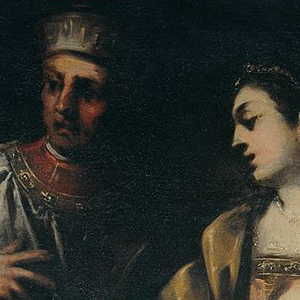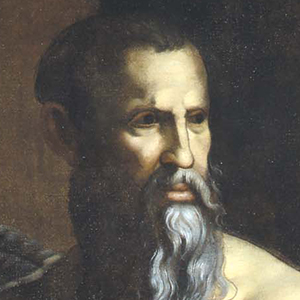The fanlights of Perseus’ room show the events of the mythical hero who was capable of achieving glorious deeds and establishing harmony among the populace. This is a clear allusion to the civil virtue of Andrea Doria and his role in pacifying Genoa. The subsequent scenes are inspired by Ovid’s work, the ‘Metamorphosis’: Jupiter, who had impregnated Danae with golden rain, had a son, Perseus, who was tasked by Polydectes to kill Medusa, who could turn a man to stone with her gaze. With Minerva’s protection the hero was able to carry out his mission, cutting off Medusa’s head and then using it to petrify Polydectes, who had persecuted Danae. In the course of his adventurous journey, Perseus was struck by the beauty of Andromeda, the young daughter of the King of Ethiopia and Cassiopeia, who he found chained to a rock when she was about to be devoured by a sea monster. The hero killed the monster and married the young girl.
The room is characterized by its refined upholstery, which includes finely-cut red velvet towels, with a design of a vase and a thistle surrounded by carnations and topped off with a crown. Those on the wall facing the sea are from the sixteenth century (those on the other walls were produced more recently, following the original design). It is commendable proof of the value of the furnishings of the Doria household, that by the fifteenth century they had amassed a precious collection of velvet and textile assets of such high quality.

The bitter conflicts which sprung up during the middle of the fifteenth century between the old and new nobility made the question of the antiquity of lineage particularly important in terms of political profile. The traditional genealogical sources gave the role of forefather of the Doria family to Arduino di Narbona, a medieval knight, who during his pilgrimage to the Holy Land fell gravely ill in Genova. It was here that he was welcomed and cared for by the noble Della Volta family. During the course of his illness, Arduino made the acquaintance of Oria Della Volta, who he married in 941 on his return from Jerusalem. Their marriage is shown in this painting from the early sixteenth century, attributed to Antonio Lagorio, a pupil of Valerio Castello. It shows the moment in which the Viscount prepares to slide the wedding ring on to his wife’s finger.

The allegorical portrait of Andrea Doria as God of the Sea, was created by Bronzino, most likely between 1545 and 1546. The work, initially thought to have been by Sebastiano del Piombo, was bought towards the end of the eighteenth century by a French restorer and then sold in Paris to the German Consul based in Genoa, who brought it to Villa del Principe, where it still resides. In the painting, Doria is represented in a heroic pose, in part inspired by Michelangelo’s David: his naked body leaning on the mast of a ship, around which is wound a rope. In his right hand he is holding an oar, and his beard is long and flowing, like that which is traditionally associated with Neptune. A slightly different version, in which Doria is holding a trident in his hand, can be found in the collection of Pinacoteca di Brera in Milan.